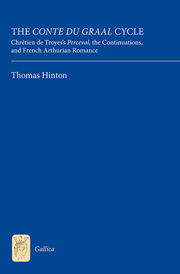 The Conte du Graal Cycle
The Conte du Graal Cycle Published online by Cambridge University Press: 05 September 2013
In this chapter I will examine how narrative aesthetic is created, promoted and contested at different points in the Conte du Graal cycle. Such a long text, with multiple authors, will inevitably change as it progresses, with successive authors choosing how to develop the narrative project inherited from their predecessors. Moreover, parts of the corpus were substantially rewritten, perhaps several times over, during the text's manuscript transmission. The following discussion will track this complex process, arguing that the cyclification of the Conte du Graal material is characterised by the imposition of two related narrative structures onto earlier, more centrifugal material: interlace, where multiple knights' adventures are woven together, and biography, with Perceval's chivalric and moral progression becoming the text's central concern. Particular attention will be paid to material which recurs or is reworked several times through the corpus, taking account of the whole manuscript tradition of the cycle. I leave until Chapter 2 a consideration of what the manuscript presentation of the cycle can tell us about its reception, focusing here on how narrative structures work to produce and promote specific textual aesthetics.
The structure of this chapter acknowledges a distinction between the diachronic and synchronic study of cyclicity – that is, the study of cyclic formation through time (the diachronic dimension) and that of the cyclic properties of an ensemble at a given stage of that formation (the synchronic dimension). Diachronic analysis traces the development of non-cyclic into cyclic material, often through successive stages in manuscript transmission; synchronic analysis considers a given cyclic manuscript or set of manuscripts as a specific and self-sufficient instance of cyclicity.
To save this book to your Kindle, first ensure [email protected] is added to your Approved Personal Document E-mail List under your Personal Document Settings on the Manage Your Content and Devices page of your Amazon account. Then enter the ‘name’ part of your Kindle email address below. Find out more about saving to your Kindle.
Note you can select to save to either the @free.kindle.com or @kindle.com variations. ‘@free.kindle.com’ emails are free but can only be saved to your device when it is connected to wi-fi. ‘@kindle.com’ emails can be delivered even when you are not connected to wi-fi, but note that service fees apply.
Find out more about the Kindle Personal Document Service.
To save content items to your account, please confirm that you agree to abide by our usage policies. If this is the first time you use this feature, you will be asked to authorise Cambridge Core to connect with your account. Find out more about saving content to Dropbox.
To save content items to your account, please confirm that you agree to abide by our usage policies. If this is the first time you use this feature, you will be asked to authorise Cambridge Core to connect with your account. Find out more about saving content to Google Drive.